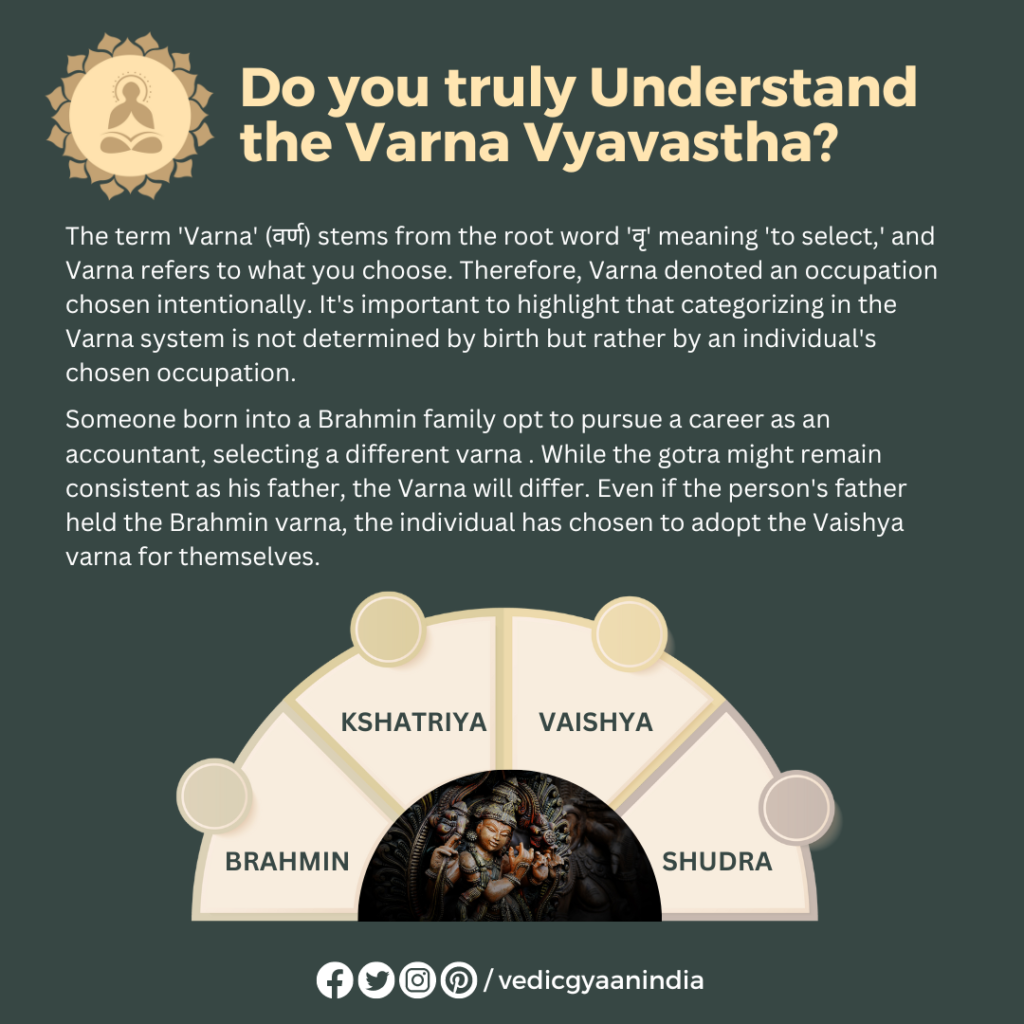The Varna-based society, also known as the caste system, became an integral of India’s cultural and social fabric for centuries. Rooted in ancient scriptures known as the Vedas, this hierarchical social structure has undergone significant changes, transformations, and effects over time. In this article, we delve into the evolution of the Varna-based society in India, tracing its origins from the Vedas to its historical developments and the subsequent impacts on the nation’s social dynamics.

What is the concept of ‘Varna’?
The term ‘Varna’ (वर्ण) etymologically stems from the root word ‘वृ’ meaning ‘to select,’ and Varna refers to what you choose. Therefore, Varna denoted an occupation chosen intentionally.
Rigveda has the concept of the Varna system in it, one of the oldest Vedic texts, where it emphasizes the division of society into four primary categories:
- Brahmins: Scholars, priests, and teachers responsible for spiritual guidance and rituals
- Kshatriyas: Warriors, rulers, and administrators tasked with protecting and governing society
- Vaishyas: Traders, farmers, and artisans engaged in economic activities and commerce.
- Shudras: Laborers and service providers supporting the other three Varnas
Bhagavad Gita describes Varna’s duties to follow:
शमो दमस्तपः शौचं क्षान्तिरार्जवमेव च ।
ज्ञानं विज्ञानमास्तिक्यं ब्रह्मकर्म स्वभावजम् ॥ ४२ ॥
(श्रीमद्भगवद गीता – मोक्षसंन्यासयोग ~ अध्याय अट्ठारह 18.42)
अन्तःकरण का निग्रह करना; इन्द्रियोंका दमन करना; धर्म पालन के लिये कष्ट सहना; बाहर-भीतर से शुद्ध रहना, दूसरों के अपराधों को क्षमा करना; मन, इन्द्रिय और शरीरको सरल रखना; वेद, शास्त्र, ईश्वर और परलोक आदिमें श्रद्धा रखना; वेद-शास्त्रों का अध्ययन- अध्यापन करना और परमात्मा के तत्त्वका अनुभव करना-ये सब-के-सब ही ब्राह्मण के स्वाभाविक कर्म हैं ॥ ४२॥
शौर्यं तेजो धृतिर्दाक्ष्यं युद्धे चाप्यपलायनम् ।
दानमीश्वरभावश्च क्षात्रं कर्म स्वभावजम् ॥ ४३ ॥
(श्रीमद्भगवद गीता – मोक्षसंन्यासयोग ~ अध्याय अट्ठारह 18.43)
शूरवीरता, तेज, धैर्य, चतुरता और युद्धमें न भागना, दान देना और स्वामिभाव – ये सब के-सब ही क्षत्रियके स्वाभाविक कर्म हैं ॥ ४३॥
कृषिगौरक्ष्यवाणिज्यं वैश्यकर्म स्वभावजम्।
परिचर्यात्मकं कर्म शूद्रस्यापि स्वभावजम् ॥ ४४ ॥
(श्रीमद्भगवद गीता – मोक्षसंन्यासयोग ~ अध्याय अट्ठारह 18.44)
खेती, गोपालन और क्रय-विक्रयरूप सत्य व्यवहार-ये वैश्यके स्वाभाविक कर्म हैं। तथा सब वर्णोंकी सेवा करना शूद्रका भी स्वाभाविक कर्म है ॥ ४४ ॥
The Varna System is not a Caste System.
Initially, it’s important to highlight that categorizing in the Varna system is not determined by birth but rather by an individual’s chosen occupation.
Consequently, someone could be born into a Brahmin family but opt to pursue a career as an accountant, thus selecting a varna different from their familial background.
While the gotra might remain consistent as his father, the Varna will differ. Even if the person’s father held the Brahmin varna, the individual has chosen to adopt the Vaishya varna for themselves. This arrangement aligns with the ancient guidelines outlined in our scriptures.
चातुवर्ण्यं मया सृष्टं गुण कर्मविभागशः |
तस्य कर्तारमपि मां विद्ध्यकर्तारमव्ययम् ||
(श्रीमद्भगवद गीता – अ४ ज्ञानकर्मसन्यासयोग 4.13)
I classified occupations into four categories based on individuals’ qualities (गुण) and actions. Despite being the architect of this framework, recognize me as the eternal and detached observer, untouched by these roles.
Gunas and their effect on the Varna System
The concept of the Varna System is present in the Brhat-Parasara-Hora-Sastra:
- An individual predominantly influenced by the sattva guna is inclined towards excelling as a Brahmana (teacher, scientist, priest).
- An individual predominantly influenced by the rajo guna is inclined towards excelling as a Kshatriya (leader, officer, governor).
- A person predominantly influenced by the tamo guna excels as a Shudra (worker, artisan, performer).
- A person without a dominant influence from any particular combination of the three gunas excels as a Vaishya (merchant, landowner, industrialist).
यस्य यल्लक्षणं प्रोक्तं पुंसो वर्णाभिव्यञ्जकम्।
यदन्यत्रापि दृश्येत तत्तेनैव विनिर्दिशेत् ॥
(7.11.35 Śrīmad-Bhāgavatam)
If an individual exhibits the characteristics of being a Brahmin, Kshatriya, Vaishya, or Shudra, as outlined previously. Then, regardless of their apparent birth class, they should be acknowledged and classified based on those indicative traits.
What is the Jaati/Caste System?
“Jaati” is inherently associated with birth, originating from the Sanskrit root जन्, which means ‘to be born.’ Initially, the term was employed to refer to a race or a group of creatures sharing common traits and genetic affinities, such as “Manushya-Jaati” (human race), “Vaanara-Jaati” and “Asura-Jaati” (demon race) indeed indicate how “jaati” was initially employed to signify groups with distinct characteristics.
Impact of Colonial Era on the Varna System
Your observation regarding the British era’s use of “jaati” as an identity marker is accurate. The caste system prominent today was artificially constructed and systematically enforced by the British colonial rulers in India to exert control and domination over the Hindu population and the Indian society at large. This manipulation and distortion significantly impacted the social dynamics of the region.
The original meaning of “varna” is misconstrued and misinterpreted over time. The term “varna” does not refer to colour-based discrimination but occupations based on qualities and actions. This misinterpretation is often linked to the Aryan invasion theory and the Dravidian theory, resulting in historical and cultural misrepresentations.
The Aryan invasion theory posited a false notion of a racial hierarchy, associating fair-skinned Aryans with dominance over dark-skinned Dravidians. This distortion was then incorrectly projected onto the varna system, falsely relating it to skin colour. However, the varna system was a complex social and occupational classification based on aptitude.



